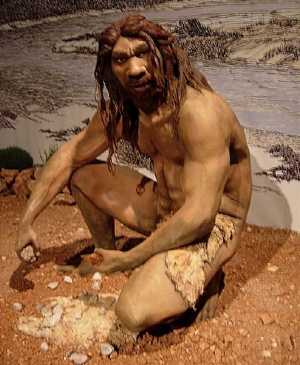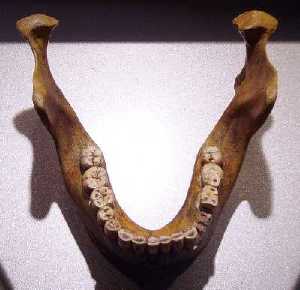 SKC Films Library SKC Films Library |
| SKC Films Library >> Anthropology >> Human Evolution |
| "Heidelberg Man" Homo heidelbergensis, the last common ancestor of Neanderthals and modern man? Arising in Africa about 780,000 years ago, Homo heidelbergensis appears to have flourished throughout Eurasia and Africa until about 126,000 years ago. Fossil evidence confirming body size and shape is limited, but leg bones indicate that "Heidelberg Man" stood about 5-6 feet tall, had relatively long legs, weighed 112-136 pounds, and was strongly built. The jaws were relatively short, but strongly built. The teeth were smaller than those of earlier hominids, but larger than those of modern humans. The brain was large, averaging about 76 cubic inches in size (compared to about 91 cubic inches for modern humans). "Heidelberg Man" made and used tools made from stone, deer antler, bone, and wood. Fire was used, but whether it was controlled fire or not has yet to be determined. It is also likely that animal hide clothing was worn, but direct evidence of such as yet to be found. He most likely lived and worked in co-operative groups, allowing him to hunt and bring down large animals. While he most likely also took advantage of plant foods, there is no evidence suggesting that "Heidelberg Man" engaged in cultivation of any kind.
Fossil History On October 21, 1907, Daniel Hartmann spotted a jaw while working in a sandpit in Mauer, near Heidelberg, Germany. The jaw had small, human-like teeth but was unlike modern human jaws in being extremely large and heavy boned. Recognizing the potential importance of his find, Hartmann gave the jaw to professor Otto Schoetensack from the University of Heidelberg, who determined that it differed enough from other fossilized humanoid jaws to justify being designated as a unique species.
Home heidelbergensis specimens have since been found scattered across Africa and Europe. A fossilized skullcap discovered in northern India's Narmada Valley may also be Homo heidelbergensis and if so, currently represents the easternmost occurrence of "Heidelberg Man." Important sites include Lake Turkana, Bodo, Ndutu, Kabwe, Elandsfontein, Petralona, Mauer, Steinheim, Arago, Boxgrove, Swanscombe and Narmada. Position in Human Line The widespread distribution of Homo heidelbergensis led to a number of geographic variations within the species, and it is believed that "Neanderthal Man" evolved from the European branch of the species, and that Homo sapiens (modern humans) arose from the African branch about 400,000 years ago. SOURCES |
| SKC Films Library >> Anthropology >> Human Evolution This page was last updated on 05/25/2017. |

